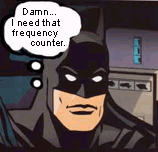 Wireless Frequency counter
Wireless Frequency counter A really important instrument for radio builders is a frequency counter.
A really important instrument for radio builders is a frequency counter. The hart of this project is the PIC processor. To this processor is 6 LED display connected.
The hart of this project is the PIC processor. To this processor is 6 LED display connected. Building and Testing
Building and Testing| fcount.zip | 18.432 MHz Crystal - PIC program frequency counter. |
| fcount2.zip | 20.000 MHz Crystal - PIC program frequency counter. |
 Final word
Final word